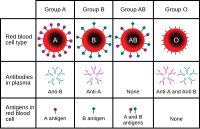
Photo from wikipedia
Background: Animal and clinical studies have shown that remote ischemic conditioning (RIC) has protective effects for cerebral vascular diseases, with induced humoral factor changes in the peripheral blood. However, many… Click to show full abstract
Background: Animal and clinical studies have shown that remote ischemic conditioning (RIC) has protective effects for cerebral vascular diseases, with induced humoral factor changes in the peripheral blood. However, many findings are heterogeneous, perhaps due to differences in the RIC intervention schemes, enrolled populations, and sample times. This study aimed to examine the RIC-induced changes in the plasma proteome using rhesus monkey models of strokes. Methods: Two adult rhesus monkeys with autologous blood clot-induced middle cerebral artery (MCA) occlusion underwent RIC interventions twice a week for five consecutive weeks. Each RIC treatment included five cycles of five minutes of ischemia alternating with five minutes of reperfusion of the forearm. The blood samples were taken from the median cubital vein of the monkeys at baseline and immediately after each week’s RIC stimulus. The plasma samples were isolated for a proteomic analysis using mass spectrometry (MS). Results: Several proteins related to lipid metabolism (Apolipoprotein A-II and Apolipoprotein C-II), coagulation (Fibrinogen alpha chain and serpin), immunoinflammatory responses (complement C3 and C1), and endovascular hemostasis (basement membrane-specific heparan sulfate proteoglycan) were significantly modulated after the RIC intervention. Many of these induced changes, such as in the lipid metabolism regulation and anticoagulation responses, starting as early as two weeks following the RIC intervention. The complementary activation and protection of the endovascular cells occurred more than three weeks postintervention. Conclusions: Multiple protective effects were induced by RIC and involved lipid metabolism regulation (anti-atherogenesis), anticoagulation (antithrombosis), complement activation, and endovascular homeostasis (anti-inflammation). In conclusion, this study indicates that RIC results in significant modulations of the plasma proteome. It also provides ideas for future research and screening targets.
Journal Title: Biomolecules
Year Published: 2021
Link to full text (if available)
Share on Social Media: Sign Up to like & get
recommendations!